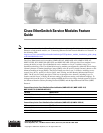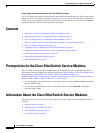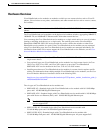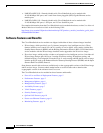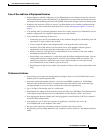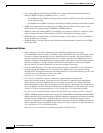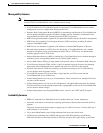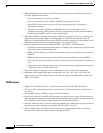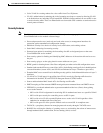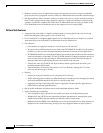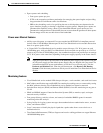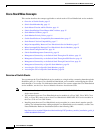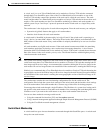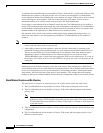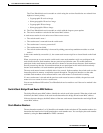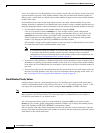
Cisco EtherSwitch Service Modules Feature Guide
Information About the Cisco EtherSwitch Service Modules
8
Cisco IOS Release 12.2(25)SEC
• IEEE 802.1D Spanning Tree Protocol (STP) for redundant backbone connections and loop-free
networks. STP has these features:
–
Up to 128 spanning-tree instances supported.
–
Per-VLAN spanning-tree plus (PVST+) for balancing load across VLANs.
–
Rapid PVST+ for balancing load across VLANs and providing rapid convergence of
spanning-tree instances.
–
UplinkFast, cross-stack UplinkFast, and BackboneFast for fast convergence after a
spanning-tree topology change and for achieving load balancing between redundant uplinks,
including gigabit uplinks and cross-stack gigabit uplinks.
• IEEE 802.1s Multiple Spanning Tree Protocol (MSTP) for grouping VLANs into a spanning-tree
instance and for providing multiple forwarding paths for data traffic and load balancing and
IEEE 802.1w Rapid Spanning Tree Protocol (RSTP) for rapid convergence of the spanning tree by
immediately transitioning root and designated ports to the forwarding state.
• Optional spanning-tree features available in PVST+, rapid PVST+, and MSTP mode:
–
Port Fast for eliminating the forwarding delay by enabling a port to immediately transition from
the blocking state to the forwarding state.
–
BPDU guard for shutting down Port Fast-enabled ports that receive bridge protocol data units
(BPDUs).
–
BPDU filtering for preventing a Port Fast-enabled port from sending or receiving BPDUs.
–
Root guard for preventing switches outside the network core from becoming the spanning-tree
root.
–
Loop guard for preventing alternative or root ports from becoming designated ports because of
a failure that leads to a unidirectional link.
• Equal-cost routing for link-level and Cisco EtherSwitch service module-level redundancy.
• Redundant power supply (RPS) support through the Cisco 2811, 2821, 2851, 3825, and 3845
integrated services routers (ISR). When an AC-IP power supply is installed, RPS is available for
ISRs as well as PoE.
VLAN Features
• Support for VLAN IDs in the full 1 to 4094 range allowed by the IEEE 802.1Q standard.
• The VLAN ID to which the port belongs (also known as its VLAN membership). The default is 1
for all ports.
• VLAN Query Protocol (VQP) for dynamic VLAN membership.
• Inter-Switch Link (ISL) and IEEE 802.1Q trunking encapsulation on all ports for network moves,
adds, and changes; management and control of broadcast and multicast traffic; and network security
by establishing VLAN groups for high-security users and network resources.
• Dynamic Trunking Protocol (DTP) for negotiating trunking on a link between two devices and for
negotiating the type of trunking encapsulation (802.1Q or ISL) to be used.
• VLAN Trunking Protocol (VTP) and VTP pruning for reducing network traffic by restricting
flooded traffic to links destined for stations receiving the traffic.



